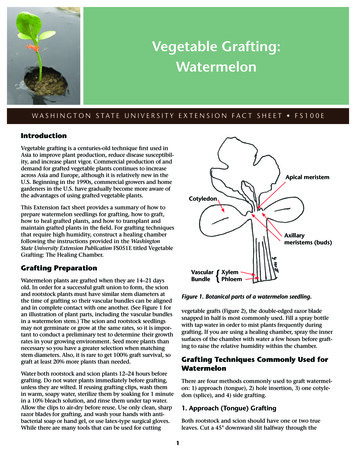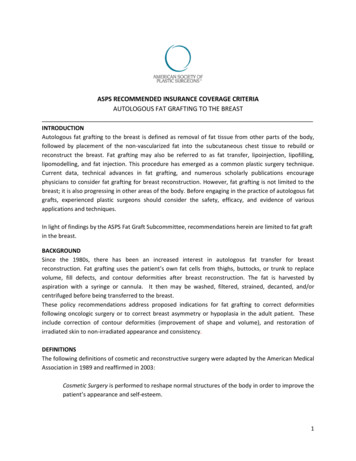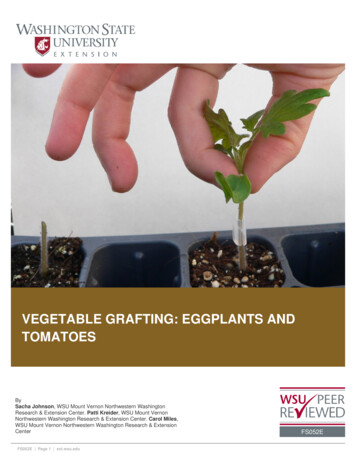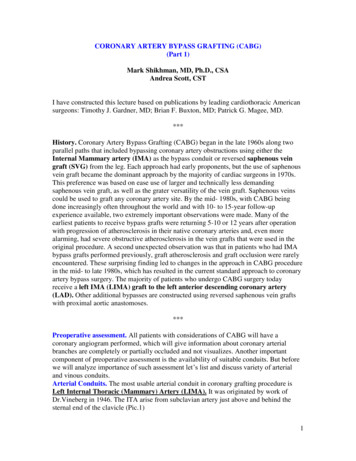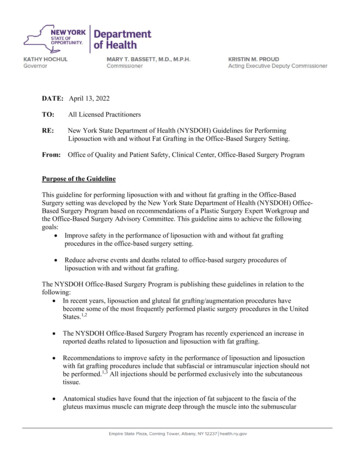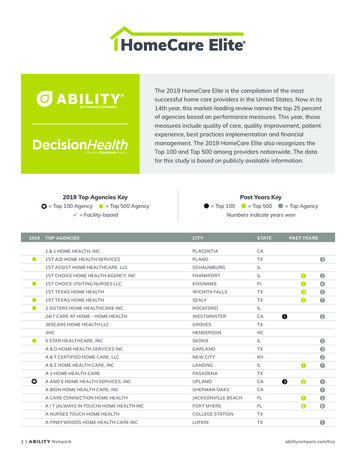
Transcription
What isFarmers' Handbook "The Fields", Chapter 7 - Top GraftingTop Grafting ?Many people would like to plantfruit trees, but often can't find goodtypes. Sometimes the seedlings maycost too much, if you have limitedincome. But difficulty in findinggood fruit trees shouldn't stop youtrying to get them - the solution to theproblem can be found. Raisingrootstock seedlings in the nurserymay take 2-3 years. After grafting, itwill take a few more years beforethey bear fruit. So let's learn an eveneasier way to grow grafted fruit trees.This is called Top Grafting (or topworking).Top grafting is a method ofgrafting cuttings (scion) fromPear, top graftedimproved fruit trees onto appropriatetypes of wild trees which are already onto a wild pear treegrowing in the fields and forests,without needing a nursery. This method is very cheap andeasy, and produces good quality fruit trees which give fruitquickly.
WhydoTop Grafting ? You can grow fruit trees on your own land You don't have to make a nursery Many types of less useful wild fruit speciescan be made into improved varieties Trees will fruit sooner and give more fruit thanotherwise Waste resources can be made into useful ones; Fruit trees can be grown easily in the forestYou can eat the fruits ofyour labour with fruit treesHowto doTop Grafting ?Materials Needed to do Top GraftingplasticsawrootstockHealthy, diseasefree, wild fruittrees are calledrootstock.sharptoolssecateursknifescionA cuttingfrom agood fruitingtree is calleda scion.2The Farmers' Handbook, "The Fields"Chapter 7 - Top Grafting3
The methods of top grafting are very similar to that ofgrafting. But while grafting is normally done in a special fruitnursery, top grafting can be done directly on the farmland orin the forest, wherever the appropriate wild fruit trees arefound.How does grafting work ?All plants have tiny channels which take water and nutrients up to the leaves and down again. These channels areinside the bark but outside the woody part of the stem. Theyform a greenish band around the stem called the cambium.Which types can you top graft onto ?Local TypewoodWhat to graftLocal peachpeach, plum, apricot, almondWild pearpearWild apple(crabapple)appleWild cherrycherrycambiumCambiumsplits whenbark ispeeled!seen fromaboveplumcherry4woodbarkappleapricotCross sectionof the inside ofa wild treecambiumpith wood (green) barkClose-up ofthe cut endof the ScionpearThe Farmers' Handbook, "The Fields"Chapter 7 - Top Grafting5
Top Grafting MethodRootstockScionScioncambium(green)To succeed attop grafting,the cambiumof the scionand the rootstock mustbe exactlymatchedThis is how thecambiums arejoinedcambium (green)Where to Top Graft ?On farmland, grazing land, or in the forest, whereverthere are suitable wild fruit trees, such as wild peach, wildpear, wild apricot, etc.1. Selecting and preparing the rootstock Top grafting can be done on any appropriate local wildfruit tree. The tree shouldbe strong, healthy andfree of disease. After selecting the tree tograft onto, clear awaybrush and weeds fromaround the base, and cutoff any small branchesgrowing from the base. Cut down the tree anywhere between 4 inches up to 3feet high above the ground, according to need and theshape of the land. The cut should be straight and clean.When to Top Graft ?Top grafting is usually done when trees have lost theirleaves, in the winter. In lower, warmer places this may be inJanuary (Northern Hemisphere). In higher, colder places thismay be February or March. It is best to top graft about 2-3weeks before new leaves sprout on the trees.The Farmers' Handbook, "The Fields"6Chapter 7 - Top Grafting7
2. Choosing and selecting the scionThe scion is selected from a good fruiting tree. Thescion is about pencil thickness, or the thickness of yourlittle finger.3. Grafting the scionhow to doTop GraftingLet's SeeSelecting therootstockThere are 3 ways to graftshown in this chapter. They areshown with photos on thefollowing pages.4. Binding the graftPlastic is used to bind thescion to the rootstock so air andwater can't get into the graft. If avery large rootstock is used, aseparate piece of plastic is neededto cover the cut section while thescion is bound. This is shown on page 11, photos 6 and 7.Cutting therootstockMethod 1.Bark TopGrafting1Let's see the 3 methods of top graftingOn the next 7 pages, 3 methods of top grafting are shown.The first method is called bark top grafting, and is on the first4 pages. After this, the second method is called tongue topgrafting, and is shown on 1 page. The third method is calledsplit top grafting and this is shown on 2 pages.8The Farmers' Handbook, "The Fields"The cutsection iscleanedChapter 7 - Top Grafting9
From thetop, make a1-2 inch longvertical cutin the bark.23On a bigrootstock, 2,3 or morescion can begrafted.5The scionshouldhave 3-5buds on it.64Make a 1-2 inchslanting cut on thelower end of the scion7Insert the cutend of the scioninto the barkthrough thevertical cut onthe rootstock.10The Farmers' Handbook, "The Fields"Spread a pieceof plastic overthe top, andbind the sciononto therootstock withanother piece.Bind tight soair and watercannot get in.Chapter 7 - Top Grafting11
Finally put anotherpiece of plastic overthe top, and bindthis on as well.8TongueTopGrafting12rootstockscionThe cut on the rootstock and the scionare both slanting andan inch long. In thecentre ofeach cutedge, make a smallnick (tongue). These 2nicks will insert into eachother to hold the graft.tongueThis showswhere care isneeded to bind wellMethod 2.Now, graftingwork is finishedon this tree.93When therootstock issmall, as here,only one scionshould begrafted.The cambium layerunder the bark of therootstock andscion should beexactly aligned(see p. 5,6)Bind the graft withplastic, as in theother methods.12The Farmers' Handbook, "The Fields"Chapter 7 - Top Grafting13
4Method 3.Cleft Top GraftingMake a cleft inthe middle ofthe cut stem.3the cut is 1 inch long2Place a sharp toolin the cleft,taking care not tosplit the stem.Make an inchlong cut on bothsides of the scion .14The Farmers' Handbook, "The Fields"4Finished 12345678901Insert n into 6789012345678901cleft. um 789012345678901the root stock123456789012345678901123456789012345678901and scion must123456789012345678901123456789012345678901be 23456789012345678901123456789012345678901Bind thegraft withplastic, asin theothermethods.Chapter 7 - Top Grafting15
After Top Grafting is successful6An improvedpear graftedonto a wild pearrootstock hassprouted well.After 4 months,the plastic isremoved. Theseedling isprotected fromlivestock.How toMaintenance maintain atop grafted seedlingAftercare for the grafted tree Protect the grafted tree from livestock Make a round trench around the plant, and use this to givewater and compost. Water as necessary, whenever possible Mulch thickly around the stem Plant companion plants around the tree Pinch or cut off any branches that sprout below the graftedbranchA grafted fruit treeorchard in Jajarkot, Nepal7Apricot, 2years afterit wasgraftedonto a localpeachHere, vegetablesare grown underthe fruit trees.16The Farmers' Handbook, "The Fields"Chapter 7 - Top Grafting17
Companion PlantingProtect the tree from livestockDarn ! I'd loveto peck at thoseleaves, but nochanceVarious plants, such as garlic, onion, marigold, basil,mint, lemon grass, comfrey, coriander, fennel, dill and wormwood can be planted around the fruit tree, which help it togrow well and give better production.Benefits of Companion Planting Companion plants help to protect from harmful pestsThey attract beneficial insectsThey produce vegetables, herbs, nectar for bees, etc.They can be cut and used as a mulchThey can be stacked densely in different layersThey help to balance the environmentThey help to conserve soil moistureThey prevent too many weeds from growingHow toeat it ?Make a small trench around the grafted tree.Use this to give water and compost as needed.Give water and compostwatercompostThere is more information about this inthe Fruit Tree Planting Method chapter18The Farmers' Handbook, "The Fields"Chapter 7 - Top Grafting19
Maintenance needed each yearcompostcompostNow your fruit treecan grow well. Tohelp it more, pruneit once a year in thewinter. Give it abasket of compostat the same time.On a big tree, many scions can be graftedTop grafted branches are shownPruning the treeRemove any branches that sprout from therootstock. More information about pruning isgiven in the Fruit Tree Planting chapter.20The Farmers' Handbook, "The Fields"Manyscions canbe graftedonto atrunk in this way.Chapter 7 - Top GraftingOne branch from therootstock is leftuncut at first. Thishelps to pull waterand nutrients fromthe roots for the newgrafts. After thegrafts have sproutedwell, this branch canbe cut off.21
Farmers'ExperienceMr Tek BahadurKhadkaFrom Jajarkot district,Khalanga -5, Pokhora village inNepal, Mr Tek BahadurKhadka has done plenty of topgrafting. Now let's read abouthis experiences.æI work for the HomesteadProgramme (JPP) in 6 VDCs ofJajarkot district. At first I didn't thinkthis method would work, but aftertraining and starting work, I like it a Tek Bahadur Khadkalot. I now teach this in the villages. Istarted by top grafting pear onto the wild pear that growshere. At first we used to cut these wild pear down as wethought they were useless. Now we top graft them and havemade a fruiting orchard out of the forest. Before, you'd seejust a few pear trees in the village. Now there are hundreds oftrees, and everyone knows how to do top grafting - even inplaces where I've never been to teach. And it turns the wildpear into a useful tree. You don't have to buy fruit seedlings,and they fruit quickly. Everyone likes the method in thevillages, it's so easy. You don't need any strange tools, and cando it in your own village area.Æ22The Farmers' Handbook, "The Fields"Read On !Subjects Related to Top GraftingThis book provides enough information for you to beable to do your own top grafting on fruit trees. However, thisinformation is also linked to other methods. For extra benefitslet's read, learn and practice from other related chapters.Top GraftingchapterGrafting it OrchardchapterFruit NurserychapterFruit TreePlanting chapterGrafting and Budding chaptersInformation about varioussimple methods to grow improvedfruit varieties at home for plantingon the farm are given in these chapters.Chapter 7 - Top Grafting23
Fruit Nursery chapterIntegrated Fruit Orchard chapterInformation is given in this chapter abouthow to plant fruit trees with various other multipurpose trees to give more and quicker benefitsfor less work.Fruit Tree Planting chapterAfter raising good seedlings in the fruitnursery, if they're not planted well all the workcan go to waste. Information about fruit treeplanting is given in this chapter.Agroforestry chapterPlanting trees on farmland can bringfarmers many benefits. But you can't plant anytype of tree, nor anywhere. This chapter givesinformation on how to plant trees withoutaffecting farm yield.Grihasthi CommunicationsIn this chapter learn how to make a nursery and grow your own fruit rootstock at homefor grafting and budding.
buds on it. Make a 1-2 inch slanting cut on the lower end of the scion Insert the cut end of the scion into the bark through the vertical cut on the rootstock. On a big rootstock, 2, 3 or more scion can be grafted. Spread a piece of plastic over the top, and bind the scion onto the rootstock with another piece. Bind tight so air and water .


